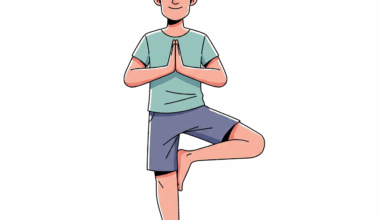Running Form Myths: What Technique Actually Helps Marathon Runners
Many myths surround the topic of running form, particularly concerning marathon training. A prevalent belief is that perfect form leads to better performance and fewer injuries. However, it’s crucial to understand what actually constitutes effective running technique. Evidence suggests that tall posture helps but not excessively straightening the back, leading to a balanced but not rigid stance while running. Analysis of runners’ biomechanics indicates variations exist among elite competitors, often refuting the notion of a single ‘best’ form. Runners must instead focus on personal comfort and efficiency. Flexibility and strength play significant roles in developing a running style that reduces strain while maximizing speed. Footwear choice also dramatically affects performance; ensuring shoes provide adequate cushion and support tailored to individual biomechanics is essential. In contrast, many fear that altering one’s natural form may cause more harm than good. Emphasizing adaptation to proper techniques within training can yield improved outcomes. Ultimately, the focus should be on consistent practice, allowing the body to adjust to new strategies rather than pursuing a mythical ‘perfect’ form that doesn’t accommodate a runner’s unique body mechanics effectively.
Another compelling myth suggests that shorter strides equate to slower pace. While in some contexts this may hold true, it doesn’t apply universally. Research shows that elite marathon runners maintain a stride length that complements their unique running rhythm. Instead of focusing solely on stride length, runners should aim for a faster cadence, enhancing running efficiency. This increased turnover prevents fatigue and encourages a smooth transition throughout the race. A consistent rhythm allows the body to conserve energy, essential during long-distance runs. Furthermore, the misconception that engaging in strength training can negatively impact running performance fails to acknowledge its benefits. Strength training enhances overall muscle endurance and power, directly correlating with improved performance in long-distance events. Runners should embrace exercises targeting the core and legs to help reduce vulnerability to injury and fatigue during races. This illustrates that proper training doesn’t solely revolve around running miles but encompasses various fitness disciplines. To dismiss strength training is shortsighted. Runners need to integrate these elements into their regimen to maximize performance and improve running dynamics significantly. Emphasis on balance is crucial, addressing muscle disparity for improved stability during the marathon.
Common Running Form Misunderstandings
One commonly held belief is that landing on the heel reduces the likelihood of injury. In contrast, many seasoned runners advocate for a mid- or forefoot landing style. This preference for a midfoot strike aligns with the natural biomechanics of human movement, promoting efficiency and shock absorption. A heel strike may place excessive stress on joints, heightening injury risk. Despite the ongoing debate, understanding body mechanics tailored to individual needs is paramount. It is crucial to find a landing style that fits well with one’s gait. Runners should also remember that all runners exhibit unique characteristics impacting their form. Another misunderstanding is that running more contributes directly to speed enhancement. However, rest and recovery bear equal importance in developing speed and endurance. Overtraining can lead to burnout and injury, ultimately hindering long-term progress. Incorporating a mix of shorter speed workouts and longer, slower runs provides a balanced approach. Listening to the body signals will promote sustainable and effective progress. Comparing oneself to others distracts from individual growth; it’s imperative to focus on personal development and enjoy the running journey while training for marathons.
Many novice marathon runners assume that technique corrections should happen overnight. This notion can lead to frustration and disillusionment, as transforming one’s running form is an ongoing process. Alterations in running technique should incorporate gradual changes rather than abrupt adjustments. Individuals must cultivate awareness, understanding that each minor adjustment takes time to instill into muscle memory. Emphasizing consistency over perfection allows runners to adapt their run without risk of injury. Marathon preparation must include patience in mastering form. Additionally, it’s important to develop personalized techniques through videos and biomechanical analysis. The use of video analysis helps ascertain areas requiring improvement, providing a tangible framework for modifications. Working with experienced coaching can offer tailored guidance and insight into effective running techniques that align with personal goals. Navigating the myriad running tips can overwhelm, especially when navigating unverified information on social media. It’s essential to rely on evidence-based training methods for reliable support. Form changes will not yield immediate results but shine through at race day, where runners realize their hard work pays off through improved efficiency and reduced fatigue during the marathon.
The Importance of Individualized Training
Understanding the necessity of individualized training approaches proves fundamental in dispelling running form myths. Every runner possesses a distinct physique and biomechanics; thus, techniques that benefit one runner may not work for another. Instead of sticking to generic advice, runners should explore methods grounded in understanding their body’s specific needs. Emphasizing the dynamic interplay between strength and flexibility promotes optimal performance. Runners should be aware that faulting their running form can lead to overwhelming self-doubt; however, incorporating strength-building exercises uniquely designed for their needs can bolster confidence. By fostering an encouraging environment, runners can actively engage in exploring what feels most natural. Allowing for adaptability and experimentation can facilitate this journey significantly. Relying on structured training with feedback safeguards against falling for trending myths. Supporting emotional well-being during marathon training encourages greater focus and motivation. Each runner should accept their journey is uniquely their own, avoiding comparisons to avoid discouragement. Ultimately, consistently testing techniques and adjusting progressively will lead to more effective running strategies as marathon goals approach. With patience and practice, runners can develop adaptable techniques that enhance their long-distance performance.
Challenging common assumptions about running form can help prevent myths from persisting within marathon training. Symposiums and expert workshops can create opportunities for knowledge sharing among runners and coaches. It’s essential to facilitate open discussions about running form, promoting a culture of informed training. Exploring customized approaches can provide insights tailored to unique needs, countering misconceptions that hinder progress. Additionally, participation in local running clubs can cultivate camaraderie among fellow runners striving for improvement. Sharing experiences and adjustments encourages consistent growth that transcends mere statistics. While strong form is a widely regarded component of marathon preparation, embracing variability leads to authentic growth. Runners should learn how to adapt their techniques subjectively rather than rigidly adhering to external expectations. Never underestimate the influence of community support in guiding technique modifications and enhancing personal training strategies. As runners prioritize enjoyment and mastery over time, they will appreciate the journey of refining their craft. Awareness of what technique helps without succumbing to rigid myths ensures the marathon experience remains fulfilling. Ultimately, evolving as a runner means navigating the complexities of form and technique while remaining true to one’s essence.
Conclusion: Moving Forward with Confidence
Marathon training is a blend of discipline and adaptability, allowing each runner to find their rhythm. Discarding prevalent myths surrounding running form enables individuals to embrace their journey with confidence. The truth about running form is that it should empower rather than constrain – runners must focus on what enhances their experience during training and races. Listening to the body and remaining open to necessary adjustments creates room for personal growth. As marathon ambitions grow, rigorous training and open-mindedness pave the way for success. By fostering a deeper understanding of unique body mechanics and performance dynamics, runners refine their approaches for optimal results. This nuanced understanding reinforces the essence of marathon running, highlighting enjoyment and fulfillment through well-defined goals. Emphasizing that every journey is different allows room for individual narratives within the marathon community. Celebrate unique progress while receiving guidance from experts where necessary. Pursue training processes centered on holistic well-being and lasting growth. Ultimately, mastering marathon techniques will connect runners more deeply with their passions, fostering a supportive community equipped to tackle challenges ahead together.
This concluding section encapsulates the emphasis on personal growth through informed choices in marathon training, reinforcing the belief that sensible technique adjustments yield benefits that extend beyond the race course. Engaging consistently in supportive environments, exchanging expertise, and nurturing emerging strengths provides a well-rounded foundation for ongoing development in skill and endurance. As runners absorb reliable information, they’ll be better equipped to find what clicks in their unique training journeys amidst the sea of ideas present. The marathon experience extends beyond the finish line, encompassing the metamorphosis experienced throughout training and the collective motivation spurred by community interaction. In this dynamic landscape, runners harness their creativity and resilience – qualities essential for enduring marathons in myriad conditions. Pasparate relationships with like-minded peers can morph into powerful motivators and learning opportunities, reflecting the commitment to continual improvement. Every mile covered builds on the foundation formed by deepening self-awareness regarding form versus technique, contributing to holistic running experiences. It’s vital to encourage a supportive atmosphere that acknowledges the diversity of training experiences and knowledge, as each runner adopts their practices to shape their marathon trajectory.


